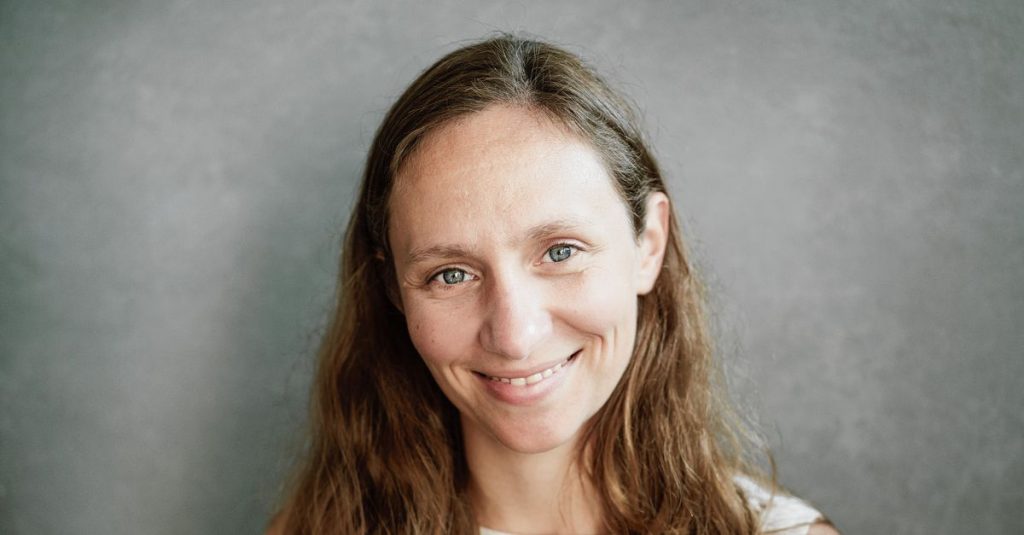“Everything in the universe comes together,” says cosmologist Elisa Cesari (1986) as she stretches her arms over her head. We arranged to meet in her office at Utrecht University. There is only a chair and a table with some books and a large blackboard with formulas of white chalk.
Keshari investigates how galaxies warp with each other by pulling them together with their own gravity. “The same phenomenon by which the Moon distorts the oceans on Earth is reflected on an enormous scale throughout the universe.” The moon pulls the oceans from different sides with its gravity. These are tidal forces and so the Moon distorts the oceans a little differently and creates tides. “The same effect also occurs between very distant galaxies.”
Tidal forces are an important source of information. “It reveals something about the evolution of the universe.” Chisari received a Vidi grant from the NWO in July of this year for her research into the effect of tidal forces on galaxies.
Photo by Frank Reuter
How can I imagine that, distorting galaxies by tidal forces?
There are millions of galaxies of different sizes and shapes. Some move towards each other. When they get close to each other, they pull each other more strongly with their attraction. Two things could happen next, depending on the shape of the galaxies. Egg-shaped galaxies extend outward when one side of the galaxy is pulled more strongly than the other. We see this deformation method very often. Spiral galaxies, such as the Milky Way that includes Earth, can slowly flip over.”
Faces?
“Yes. You have to imagine that a spiral galaxy is spinning on its axis over another galaxy. The other galaxy, with its gravity, is holding the spiral galaxy. The galaxy begins to pull and flip the spiral.”
Does the Milky Way flip, too?
“No, we have not seen this before in the Milky Way. We have just seen this phenomenon and we don’t know exactly how it works yet. The galaxies we have seen are very far away.”
And if the Milky Way did flip, would it be noticeable on Earth?
“No, on Earth we only feel tidal forces from nearby celestial bodies, like the Moon. We won’t notice anything about flipping.”
Why are you so excited to learn how tidal forces distort galaxies?
“How tides affect galaxies teaches us something about the beginning of the universe, shortly after the Big Bang. We don’t really understand the physics of the early universe. Astronomers can only look back in time to a limited extent. The light that now reaches Earth from a galaxy billions of light years away from Earth is billions of years old.Only, light cannot move freely through space until about 380,000 years after the Big Bang.Before that time, the density in the universe was still very high.However , the imprints dating back to 380,000 years after the Big Bang are still hidden in the way galaxies align now.From various physics theories about the early universe, galaxies should now interact differently with tides.
Most of the universe is unknown
And understanding how tidal forces distort galaxies is also important for something else entirely. Light traveling from a distant galaxy to Earth is deflected along the way. As a result, the galaxy appears distorted when viewed from Earth. We want to separate the effect of the so-called gravitational lens from the tidal effects. Physicists are using the gravitational lens to study two major unsolved problems in physics.”
Which one then?
“Most of the universe is unknown. We only know about 5 percent of the matter around us. 25 percent is hypothetical dark matter. These are probably hitherto unknown particles. We don’t see them. They don’t emit light, but they betray themselves with their mass that They are pulled out by their environment, by gravity.The other 70 percent is dark energy.This is a hypothetical form of energy that is causing the universe to expand more and more.
“I work with astronomers in Leiden who study gravitational lenses to discover the properties of dark energy and dark matter. We use models that simulate the effect of tides on galaxies to distinguish between the two different effects.”
How do you do that, modeling the shapes of galaxies from your office in Utrecht?
“I used to have a romantic idea that astronomers spend their nights looking through a telescope somewhere on the top of a mountain. So it is not. From Utrecht, I have analyzed observations that come from large telescopes like the VLT Survey Telescope in Chile. In some Sometimes I theorize with pen and paper. Sometimes I work with computer models.”
I have a telescope that I use in my spare time
Would you rather do that by looking through a telescope at night?
“No, I really like the variety now in my research. I have a telescope that I use in my spare time. When I was a teenager, I got the first. After that, my family, at my request, wanted to buy it for me. To determine which one I want, I did a lot of research on What different telescopes can do.I found that very interesting at the time.
“I grew up in Buenos Aires, where our house was always full of books on astronomy from my father. As a kid, I flipped his books and imagined why the universe existed and why it looks the way it is.”
And with your telescope, you can sometimes admire the “lower” things in the universe from galaxies… the moon and the planets in the solar system.
He laughs: “Yes. And during my high school I did a little research on something completely different. My high school had an observatory where I took an astronomy course. I did my research project there with a telescope and noticed a group of stars born from the same cloud. Our task is to investigate at what stage of the Its development was mass. That was my first research experience. That was impressive.”

“Total coffee specialist. Hardcore reader. Incurable music scholar. Web guru. Freelance troublemaker. Problem solver. Travel trailblazer.”









More Stories
Brabanders are concerned about climate change.
The “term-linked contract” saves space on the electricity grid.
The oystercatcher, the “unlucky national bird,” is increasingly breeding on rooftops.